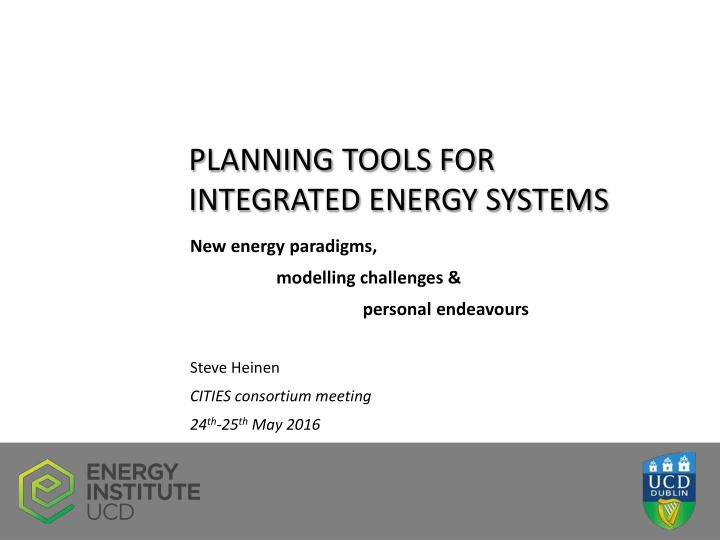



PLANNING TOOLS FOR INTEGRATED ENERGY SYSTEMS New energy paradigms, modelling challenges & personal endeavours Steve Heinen CITIES consortium meeting 24 th -25 th May 2016
Energy planning using mathematical models Energy planning provides insights on Infrastructure (Investment, technology development) and • Strategy (political alliances, policy and business development, public awareness- • building, education) “Future-now thinking” RAND Corporation “Planning is bringing the future into the present so that you can do something about it now.” Alan Lakein Mathematical modelling is a tool Decision-making support to identify planning challenges and find solutions • Analytical tool to support human judgement, which is biased and not just driven by • logic “The purpose of computing is insight, not numbers.” Richard Hamming “We're generally overconfident in our opinions and our impressions and judgments.” Daniel Kahneman
NEW ENERGY PARADIGMS DRIVING DEVELOPMENT OF ENERGY PLANNING TOOLS
New paradigms integrate the energy system across fuels, scales and layers 4 Flexible demand and consumer participation enabled by ICT technologies and distributed generation Active demand Electrification of demand side (heat and transport and penetration of variable renewables Temporal detail Distributed resources, renewable resource potential and networks (electricity, heat, biogas) Spatial detail Rapid tech innovation, market liberalisation and regulation Uncertainty Unlike detailed sector-specific models, an integrated model captures couplings and interactions and, if those are significant, it reveals integration challenges and opportunities
Modelling challenge: Resolve temporal and spatial resolutions 5 Investment planning Power sys operation Time Scale Temporal resolution Spatial resolution Interdependencies between scales and layers impact planning
Modelling challenge …and long-term planning uncertainties 80 Oil price ($/b) PV cost ($/W) Policy and regulation • 100 Technology-specific grant Feed-in tariffs 50 Market design 0.74 $/W Population growth and lifestyle • 1970 2010 Economic development • 1977 2013 Geopolitics • Fuel prices • Carbon prices • Technology development • Technology acceptability • Climate •
The modelling trilemma Long-term uncertainty -fuel prices -policies Dream (or Goal?) -public acceptability Social science -technology development Spatial detail -network expansion Economics -plant/device/storage location -heterogeneous consumer Engineering Temporal detail -renewables variability -demand variability No model can cover it all, approximations needed But approximations can only be made by understanding the details “ The art of being wise is the art of knowing what to overlook.” William James
Model categorisations Simulation/forecasts predictive • EnergyPlan, LEAP, NEMS o Challenge: designing control variables o Optimization/scenarios normative • Investment planning/Capacity expansion: TIMES, Markal, o Balmoral, Netplan, WASP Operations planning: Plexos, WILMAR o Challenge: balancing model temporal and spatial resolution o with data availability and computational tractability Market/strategic stakeholder behaviour • Agent-based models: EMCAS o Challenge: limited representation of physical energy system, o computational tractability for larger systems
PERSONAL ENDEAVOURS
Scope: Electrifying heat in Irish domestic sector 10 Peak load Renewables management balancing >80% of today’s buildings Heater upfront still standing in 2050 cost Heat distribution system compatibility
Model overview Started off with simulation model (proof-of-principle) and Description: grew into optimisation model… • Planning stage: 1-stage • Normative: Optimisation Other demand (residential non-heat, • Temporal resolution: full hourly commercial and industrial sectors) representation a year Electricit y Wind • Spatial representation: representative Coal ST Buffer μ CHP tank Gas CCGT houses using RC model Gas OCGT Oil CT Space heat • deterministic or stochastic demand Storage • Power plants. Group dispatch (LP) or tank B R Natural individual units (MILP) Hot water Gas H demand Single/hybrid Objective: P heater Study boundary • System cost minimisation (or Other demand (residential non-heat, commercial and industrial sectors) risk/CVaR minimisation) Inputs: • Fuel prices, technology Capacity [MW] Capacity [MW] Capacity [MW] characteristics and cost, demand Dispatch ( ∀ hr) Dispatch ( ∀ hr) Dispatch ( ∀ hr) data Binary ( ∀ hr) Binary ( ∀ hr) Investment cost Operational cost
Capturing planning uncertainties 1. Deterministic. Vast 2. Stochastic. Optimising conditional value number of scenarios at risk for stochastic gas prices Efficient Frontier • Natural gas price (3x) • Carbon price (3x) • Domestic heat technology (6x) • Heater investment cost (6x2) • Thermal storage cost (2x) • Building insulation (3x) • Temperature and wind profile (2x2) ~15 000 scenarios Conditional VaR (CVaR) • Represents downside risk and risk averseness of decision- makers (losses loom larger than gains) • Convex (can be formulated as LP)
Challenges for Energy System Planning as a discipline Availability and openness of code • Code may not be available in publications, which makes it difficult to compare to other results and guarantee reproducibility Data • Data used in a study may not be publically available or confidential for commercial reasons Validation • Establish test systems, benchmarking, Monte-Carlo simulations Modelling consumer behaviour • Consumer role is often too simplified. Consumers are heterogeneous groups of active agents that do not behave fully rationally, but are driven by a variety of other emotional, social and circumstantial parameters.
14 “ Plans are useless, Planning is indispensable .” Dwight D. Eisenhower Thank you for your attention Thanks to Prof. Mark O’Malley Supported by • CITIES project, Denmark (Project Ref. 1305-00027B/DSF) • Fonds National de la Recherche, Luxembourg (Project Ref. 6018454)
Further reading A. Foley, B. Ó Gallachóir, J. Hur, R. Baldick, and E. McKeogh. A strategic review of • electricity systems models. Energy, 35(12):4522–4530, 2010. A. Shortt, J. Kiviluoma, and M. O’Malley, Accommodating Variability in Generation • Planning, IEEE Transactions On Power Systems, Vol. 28, No. 1, February 2013 E. Trutnevyte, The allure of energy visions: Are some visions better than others?, • Energy Strategy Reviews, Volume 2, Issues 3–4, February 2014, Pages 211-219 J. F. DeCarolis, K. Hunter, and S. Sreepathi. The case for repeatable analysis with • energy economy optimization models. Energy Economics, 34(6):1845–1853, 2012. S. Heinen, D. Burke, and M. O’Malley. Electricity, gas, heat integration via residential • hybrid heating technologies - an investment model assessment. Energy. 2016 (in Press).
Recommend
More recommend